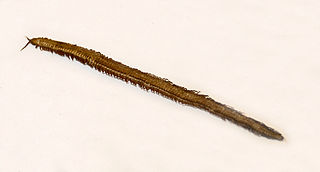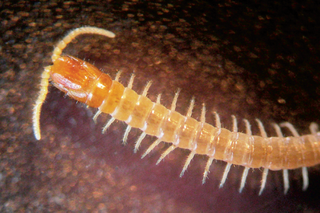
Himantariidae is a monophyletic family of centipedes in the order Geophilomorpha and superfamily Himantarioidea, found almost exclusively in the Northern Hemisphere. Centipedes in this family feature a short head with a concave labral margin bearing a row of denticles, a single dentate lamella and some pectinate lamellae on each mandible, second maxillae with strongly tapering telopodites and slightly spatulate claws, and a stout forcipular segment with short forcipules and a wide tergite; the ultimate legs usually have no pretarsus, and the female gonopods are distinct and biarticulate.

Himantarium is a genus of centipedes in the family Himantariidae. Centipedes in this genus feature a swollen trunk that is posteriorly stout, subcircular sternal pore-fields on almost all trunk segments, much inflated coxapleura completely covered with scattered pores, and a very small metasternite on the ultimate leg-bearing segment; each mandible has a robust dentate lamella and few pectinate lamellae. These centipedes range from 10 cm to 20 cm in length, have from 87 to 179 pairs of legs, and are found in the Mediterranean region. Both the minimum and the maximum number of legs in this genus appear in the species Himantarium gabrielis, which exhibits a striking degree of intraspecific variation in leg number.

Oryidae is a monophyletic family of soil centipedes belonging to the superfamily Himantarioidea.

Mecistocephalidae is a monophyletic family of centipedes in the order Geophilomorpha. It is the only family in the suborder Placodesmata. Most species in this family live in tropical or subtropical regions, but some occur in temperate regions. This family is the third most diverse in the order Geophiliomorpha, with about 170 species, including about 130 species in the genus Mecistocephalus.

Geophilus is a large, heterogeneous genus of soil centipedes in the family Geophilidae largely considered to be synonymous with Brachygeophilus. This genus is a mostly holarctic and characterized by a claw-shaped ultimate pretarsus, anterior porefields, complete or nearly complete coxo-pleural sutures at the prosternum, and incomplete chitin-lines. Centipedes in this genus feature slightly elongate heads and labral intermediate parts with tubercles, the forcipules are usually poorly elongate with a single small tubercle at the base of each tarsungulum, and the anterior trunk metasternites usually have an anterior medial socket and a posterior transversally elongate pore-field. The generic name first appeared in Brewster's Edinburgh Encyclopaedia in 1814 as Geophilus electricus.
Arrup is a genus of centipedes in the family Mecistocephalidae, native to Europe and Asia as far as Japan. Centipedes in this genus feature small telopodites on the second maxillae, the head and forcipular segment are elongate, the clypeus is almost completely areolate, and the poison glands in adult males are often deep inside the forcipules. These centipedes range from 1 cm to 5 cm in length. All species in this genus have 41 leg-bearing segments. Most are soil-dwellers but Arrup akiyoshiensis is a troglobiont.
Agnostrup is a genus of centipedes in the family Mecistocephalidae, native to Europe and Asia. Centipedes in this genus feature small telopodites without claws on the second maxillae and a robust basal denticle on the forcipular tarsungulum. These centipedes range from 2 cm to 3 cm in length. All species in this genus have 41 leg-bearing segments.
Anarrup is a genus of centipedes in the family Mecistocephalidae, native to Europe and Asia as far as Indonesia. Centipedes in this genus feature a clypeus with areolation and setae limited to a short anterior marginal band; the second maxillae have swollen and densely setose telopodites and a coxosternite divided mid-longitudinally. These centipedes range from 6 cm to 8 cm in length. All species in this genus have 41 leg-bearing segments.
Queenslandophilus is a genus of centipedes in the family Geophilidae. It was described by German myriapodologist Karl Wilhelm Verhoeff in 1925. Centipedes in this genus feature second maxillae with sclerotized ridges on the coxosternite, no sternal pores, and coxopleura many scattered pores; the lateral parts of the labrum almost touch medially, and the ultimate legs most often have claws. These centipedes range from 1 cm to 6 cm in length, have 37 to 75 pairs of legs, and are found in Australia, Japan, and North America. The Japanese species Queenslandophilus monoporus and Q. macropalpus are notable for their small sizes, measuring only 10 mm and 15 mm in length, respectively. The species Q. elongatus, found in California, is notable for its large size, ranging from 40 mm to 63 mm in length. The species Q. macropalpus has only 37 leg pairs, the minimum number recorded in this genus, whereas Q. elongatus has 73 to 75 leg pairs, the maximum number recorded in this genus.
Tasmanophilus is a genus of two species of centipedes, in the family Zelanophilidae. It was described by American biologist Ralph Vary Chamberlin in 1920. Centipedes in this genus are found in Australia and New Zealand.
Tuoba is a genus of 17 species of centipedes, in the family Geophilidae. It was described by American biologist Ralph Vary Chamberlin in 1920.
Zelanophilus is a genus of three species of centipedes, in the family Zelanophilidae. This genus was described by American biologist Ralph Vary Chamberlin in 1920. Centipedes in this genus are found in Australia and New Zealand.
Mecistocephalus is a genus of centipedes in the family Mecistocephalidae. It was described by British entomologist George Newport in 1843.
Australoschendyla is a genus of centipedes in the family Schendylidae. It was described by R. E. Jones in 1996. Centipedes in this genus feature claws on the second maxillae fringed by a single row of filaments, short forcipules, subcircular sternal pore-fields, one or two pores on each coxopleuron, and ultimate legs without claws. These centipedes range from 1 cm to 2 cm in length, have 41 to 47 pairs of legs, and are found in west Australia.
Schendyla is a genus of centipedes in the family Schendylidae. It was described by Danish entomologists Vilhelm Bergsøe and Frederik Vilhelm August Meinert in 1866. Centipedes in this genus feature only a few spines on the claws of the second maxillae, two pores on each coxopleuron, and ultimate legs without claws. These centipedes range from 1 cm to about 4 cm in length and have from 31 to 57 pairs of legs. The species Schendyla verneri is notable for its small size and for having only 31 leg pairs, the minimum recorded in this genus. Other small species with notably few legs in this genus include S. walachica, S. dalmatica, S. dentata, S. gracillima. and S. armata. The species S. monoeci measures only 17.5 mm in length but can have from 51 to as many as 57 leg pairs, the maximum number found in this genus. Descriptions of the species S. vizzavonae report no more than 51 leg pairs, but this species is notable for its relatively large size, reaching 45 mm in length.
Maoriella is a genus of centipedes in the family Geophilidae. It was described by Austrian myriapodologist Carl Attems in 1903. Species in this genus are found in New Zealand, Australia, and Tahiti.
Gonibregmatus is a genus of centipedes in the family Gonibregmatidae. It was described by British entomologist George Newport in 1843.
Ityphilus is a genus of centipedes in the clade Ballophilidae. It was described by American myriapodologist Orator Fuller Cook in 1899. Centipedes in this genus feature distinctly club-like antennae, well marked sclerotized lines on the forcipular coxosternite, and two pores on each coxopleuron. These centipedes range from about 1 cm to about 9 cm in length and have 41 to 113 pairs of legs. The dwarf species Ityphilus donatellae ranges from 8.5 to 11 mm in length and can have as few as 41 leg pairs, the minimum number found in this genus. The large species I. grandis can reach 93 mm in length and have as many as 113 leg pairs, the maximum number found in the clade Ballophilidae.
Marsikomerus is a genus of centipedes in the family Schendylidae. It was described by Austrian myriapodologist Carl Attems in 1938. Species in this genus are found in Mexico and in the United States.
Eucratonyx is a genus of centipedes in the family Gonibregmatidae. This genus was described in 1898 by British zoologist Reginald Innes Pocock. Centipedes in this genus are found from the Andaman Islands to New Britain.





